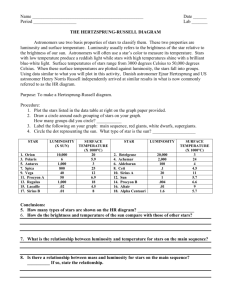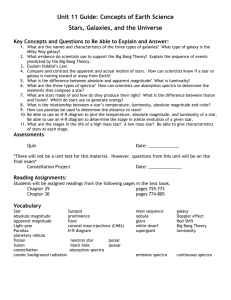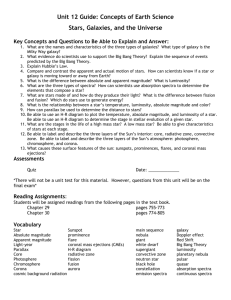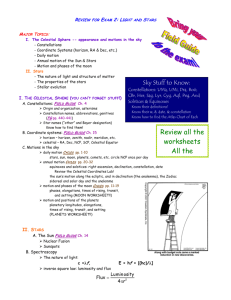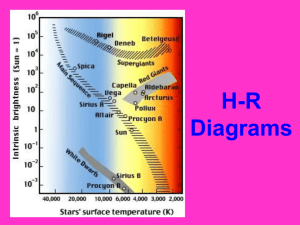Star Information ppt.
advertisement
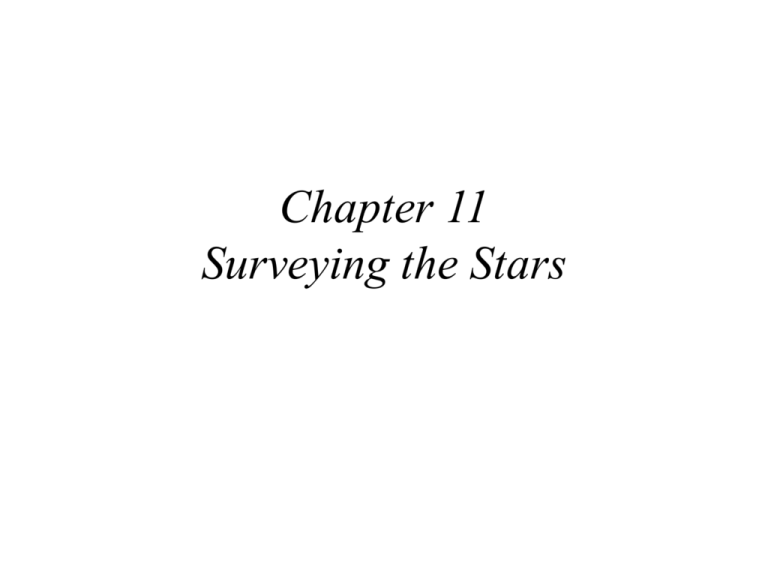
Chapter 11 Surveying the Stars 11.1 Properties of Stars • Our Goals for Learning • How luminous are stars? • How hot are stars? • How massive are stars? How luminous are stars? The brightness of a star depends on both distance and luminosity Luminosity: Amount of power a star radiates (energy per second=Watts) Apparent brightness: Amount of starlight that reaches Earth (energy per second per square meter) Thought Question These two stars have about the same luminosity -which one appears brighter? A. Alpha Centauri B. The Sun Thought Question These two stars have about the same luminosity -- which one appears brighter? A. Alpha Centauri B. The Sun Luminosity passing through each sphere is the same Area of sphere: 4π (radius)2 Divide luminosity by area to get brightness The relationship between apparent brightness and luminosity depends on distance: Luminosity Brightness = 4π (distance)2 We can determine a star’s luminosity if we can measure its distance and apparent brightness: Luminosity = 4π (distance)2 x (Brightness) Thought Question How would the apparent brightness of Alpha Centauri change if it were three times farther away? A. B. C. D. It would be only 1/3 as bright It would be only 1/6 as bright It would be only 1/9 as bright It would be three times brighter Thought Question How would the apparent brightness of Alpha Centauri change if it were three times farther away? A. B. C. D. It would be only 1/3 as bright It would be only 1/6 as bright It would be only 1/9 as bright It would be three times brighter How hot are stars? Every object emits thermal radiation with a spectrum that depends on its temperature An object of fixed size grows more luminous as its temperature rises Laws of Thermal Radiation 1) Hotter objects emit more light at all wavelengths 2) Hotter objects emit light at shorter wavelengths and higher frequencies Hottest stars: 50,000 K Sun’s surface is 5,800 K Coolest stars: 3,000 K 106 K 105 K 104 K Ionized Gas (Plasma) 103 K Neutral Gas 102 K Molecules 10 K Solid Level of ionization also reveals a star’s temperature Absorption lines in star’s spectrum tell us ionization level Lines in a star’s spectrum correspond to a spectral type that reveals its temperature (Hottest) O B A F G K M (Coolest) Remembering Spectral Types (Hottest) O B A F G K M • Oh, Be A Fine Girl, Kiss Me (Coolest) Thought Question Which kind of star is hottest? A. B. C. D. M star F star A star K star Thought Question Which kind of star is hottest? A. B. C. D. M star F star A star K star How massive are stars? The orbit of a binary star system depends on strength of gravity Types of Binary Star Systems • Visual Binary • Eclipsing Binary • Spectroscopic Binary Binary Star- double star system that orbit each other About half of all stars are in binary systems Visual Binary We can directly observe the orbital motions of these stars Visual Binary – Orbit around each other Eclipsing Binary Eclipsing Binary- Stars that eclipse each other as they circle (Vary in Brightness) Most massive stars: 100 MSun Least massive stars: 0.08 MSun (MSun is the mass of the Sun) What have we learned? How luminous are stars? • The apparent brightness of a star in our sky depends on both its luminosity —the total amount of light it emits into space—and its distance from Earth, as expressed by the inverse square law for light. What have we learned? • How hot are stars? • The surface temperatures of the hottest stars exceed 40,000 K and those of the coolest stars are less than 3,000 K. We measure a star’s surface temperature from its color or spectrum, and we classify spectra according to the sequence of spectral types OBAFGKM, which runs from hottest to coolest. What have we learned? • How massive are stars? • The overall range of stellar masses runs from 0.08 times the mass of the Sun to about 100 times the mass of the Sun. 11.2 Classifying Stars Our Goals for Learning • How do we classify stars? • Why is a star’s mass its most important property? • What is a Hertzsprung–Russell diagram? How do we classify stars? Most of the brightest stars are reddish in color Color and luminosity are closely related among the remaining “normal” stars Main-sequence stars – Normal stars like our sun that are fusing hydrogen into helium in their cores. Luminous mainsequence stars are hot (blue) Less luminous ones are cooler (yellow or red) Why are some red stars so much more luminous? They’re bigger! Biggest red stars: 1000 Rsun Smallest red stars: 0.1 RSun A star’s full classification includes spectral type (line identities) and luminosity class (line shapes, related to the size of the star): I - supergiant II - bright giant III - giant IV - subgiant V - main sequence Examples: Sun - G2 V Sirius - A1 V Proxima Centauri - M5.5 V Betelgeuse - M2 I Why is a star’s mass its most important property? Each star’s properties depend mostly on mass and age Each star’s properties depend mostly on mass and age Stellar Properties Review Luminosity: from brightness and distance 10-4 LSun - 106 LSun Temperature: from color and spectral type 3,000 K - 50,000 K Mass: from period (p) and average separation (a) of binary-star orbit 0.08 MSun - 100 MSun Stellar Properties Review Luminosity: from brightness and distance (0.08 MSun) 10-4 LSun - 106 LSun (100 MSun) Temperature: from color and spectral type (0.08 MSun) 3,000 K - 50,000 K (100 MSun) Mass: from period (p) and average separation (a) of binary-star orbit 0.08 MSun - 100 MSun Core pressure and temperature of a higher-mass star are larger in order to balance gravity Higher core temperature boosts fusion rate, leading to larger luminosity Mass & Lifetime Sun’s life expectancy: 10 billion years Mass & Lifetime Sun’s life expectancy: 10 billion years Until core hydrogen (10% of total) is used up Mass & Lifetime Sun’s life expectancy: 10 billion years Until core hydrogen (10% of total) is used up Life expectancy of 10 MSun star: 10 times as much fuel, uses it 104 times as fast 10 million years ~ 10 billion years x 10 / 104 Mass & Lifetime Sun’s life expectancy: 10 billion years Until core hydrogen (10% of total) is used up Life expectancy of 10 MSun star: 10 times as much fuel, uses it 104 times as fast 10 million years ~ 10 billion years x 10 / 104 Life expectancy of 0.1 MSun star: 0.1 times as much fuel, uses it 0.01 times as fast 100 billion years ~ 10 billion years x 0.1 / 0.01 Main-Sequence Star Summary High Mass: High Luminosity Short-Lived Large Radius Blue Low Mass: Low Luminosity Long-Lived Small Radius Red What is a Hertzsprung-Russell Diagram? Luminosity An H-R diagram- plots the luminosity and temperature of stars Temperature Main sequenceNormal hydrogenburning stars reside on the of the H-R diagram Large radius Small radius Stars with low temperature and high luminosity must have large radius SUPERGIANTS GIANTS Stars with low temperature and high luminosity must have large radius H-R diagram depicts: Luminosity Temperature Color Spectral Type Luminosity Radius *Mass *Lifespan *Age Temperature C Luminosity B Which star is the hottest? D A Temperature B C B C Which star is the hottest? Luminosity A D A A Temperature D C Luminosity B Which star is the most luminous? D A Temperature C Luminosity B Which star is the most luminous? C D A Temperature C Luminosity B Which star is a main-sequence star? D A Temperature C B Which star is a main-sequence star? Luminosity D D A Temperature C Luminosity B Which star has the largest radius? D A Temperature C B Which star has the largest radius? Luminosity C D A Temperature A Luminosity D B C Temperature Which star is most like our Sun? A Which star is most like our Sun? Luminosity D B C Temperature B A Luminosity D B C Temperature Which of these stars will have changed the least 10 billion years from now? A Luminosity D B C C Temperature Which of these stars will have changed the least 10 billion years from now? A Luminosity D B C Temperature Which of these stars can be no more than 10 million years old? A Luminosity D A B C Temperature Which of these stars can be no more than 10 million years old? What have we learned? • How do we classify stars? • Why is a star’s mass its most important • We classify stars according to their spectral type and property? • A star’s mass at birth luminosity class. determines virtually • The spectral type tells us everything that happens the star’s surface to it throughout its life. temperature • The luminosity class how much light it puts out. What have we learned? • What is a HertzsprungRussell diagram? • An H–R diagram plots stars according to their surface temperatures and luminosities. 11.3 Star Clusters • Our Goals for Learning • What are the two types of star clusters? • How do we measure the age of a star cluster? What are the two types of star clusters? Open cluster: A few thousand loosely packed stars Globular cluster: Up to a million or more stars in a dense ball bound together by gravity How do we measure the age of a star cluster? Massive blue stars die first, followed by white, yellow, orange, and red stars Pleiades now has no stars with life expectancy less than around 100 million years Main-sequence turnoff Mainsequence turnoff point of a cluster tells us its age To determine accurate ages, we compare models of stellar evolution to the cluster data Detailed modeling of the oldest globular clusters reveals that they are about 13 billion years old What have we learned? • What are the two types of star clusters? • Open clusters contain up to several thousand stars and are found in the disk of the galaxy. • Globular clusters contain hundreds of thousands of stars, all closely packed together. They are found mainly in the halo of the galaxy. What have we learned? • How do we measure the age of a star cluster? • Because all of a cluster’s stars we born at the same time, we can measure a cluster’s age by finding the main sequence turnoff point on an H–R diagram of its stars. The cluster’s age is equal to the hydrogenburning lifetime of the hottest, most luminous stars that remain on the main sequence.



